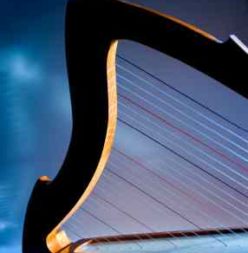Why improvise with the harmonic minor scale? For starters, it’s a lot of fun. The harmonic minor scale has a moody, mysterious sound, and almost anything you play will sound great.
If your harp is tuned in C (or you’ve put up your levers for C), engage your G# levers. In your left hand, play the following chords in succession (called a chord progression): Am, E, F, E. (The notes in those chords are ACE, EG#B, FAC, and again EG#B). Let’s use 4/4 time and play the chord just on beat 1, changing chords every two measures.
Now, in the right hand, you may play any notes, but you’ll notice that when your LH chord is F, the G# sounds rather dissonant, so you might want to avoid it on those measures. That same G# gives the harmonic minor it’s distinctive sound, creating the E major chord instead of an E minor chord. Whether you understand that music theory or not, you can have fun experimenting with this scale.
Glissing and fluttery patterns are very satisfying with this tuning. Let go of looking for the “right notes” and just experiment.
By the way, if you have only F, C and B levers on your harp, disengage the B’s to create Bbs, and then engage the C#s. Now your harmonic minor scale is Dm. Play Dm, A, Bb, and A chords to go with this scale, and avoid the C# when playing the Bb chord. (Chord notes are DFA, AC#E, BbFD, AC#E).
Most of all, have fun!
This post is adapted from material that I originally published in the ezine, Notes from the Harp.
